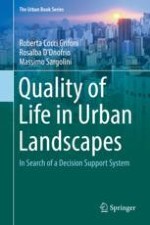2018 | OriginalPaper | Buchkapitel
5. Selection of Indicators of Urban Sustainability and Quality of Life of City Inhabitants
verfasst von : Rosalba D’Onofrio, Massimo Sargolini, Michele Talia
Erschienen in: Quality of Life in Urban Landscapes
Aktivieren Sie unsere intelligente Suche, um passende Fachinhalte oder Patente zu finden.
Wählen Sie Textabschnitte aus um mit Künstlicher Intelligenz passenden Patente zu finden. powered by
Markieren Sie Textabschnitte, um KI-gestützt weitere passende Inhalte zu finden. powered by
